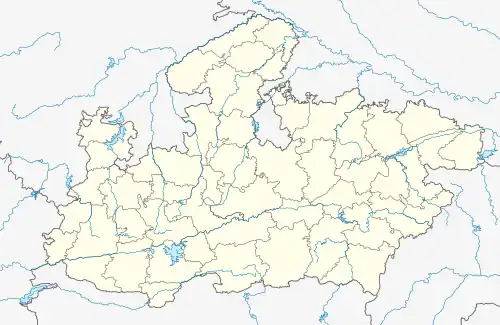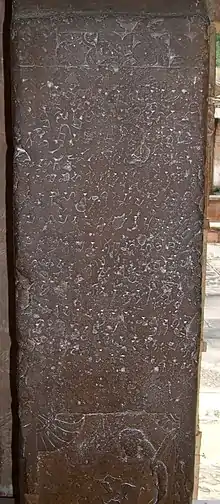Hāsalpur | |
|---|---|
village | |
 Hāsalpur  Hāsalpur | |
| Coordinates: 25°33′50″N 76°30′50″E / 25.5638°N 76.5140°E | |
| Country | India |
| State | Madhya Pradesh |
| Region | Gird |
| District | Gwalior |
| Elevation | 196 m (643 ft) |
| Population | |
| • Total | 1,822 |
| Languages | |
| • Official | Hindi |
| Time zone | UTC+5:30 (IST) |
| PIN | 474001 (HPO) |
The Hāsalpur inscription of Nāgavarman is an epigraphic record on a memorial stone documenting the exploits of a ruler named Nāgavarman. It is not dated but has been assigned to the mid-sixth century CE.
Location
Hāsalpur (sometimes Hansalpur or Hasilpur) is located in Sheopur District near the River Chambal in northern Madhya Pradesh, India. The nearest town is Dhodhar where a small fort is situated. The memorial stone is now in the Archaeological Museum at Gwalior.

Publication
The inscription was first noted by M. B. Garde in 1916-17 and again in 1934.[1] It was later listed by H. N. Dvivedī, H. V. Trivedi and Michael Willis.[2] The listing in the Annual Report on Indian Epigraphy for 1952-52 gives the wrong find-spot.[3] An illustration of the hero-stone appeared in the Journal of the Royal Asiatic Society in 1970.[4]
Description and contents
The inscription is written in Sanskrit over 13 lines. The exact contents have not been reported but Nāgavarman seems to be among the local kings who rose against Mihirakula and the Hūṇas in the early to mid-sixth century.
Text
The inscription has been read only in part. The king's name is given in line 4.
1)
2)
3)
4) mahārāja-nāgavarmma-

See also
References
- ↑ GAR (VS 1973/AD 1916-17): number 21; Garde, Archaeology in Gwalior (Gwalior, 1934): 18.
- ↑ Dvivedī (VS 2004): number 708; Trivedi (1953): 15; Michael D. Willis, Inscriptions of Gopakṣetra (London, 1996).
- ↑ ARE (1952-53): B, number 170.
- ↑ J. C. Harle, "An early Indian hero-stone and a possible Western source," JRAS (1970): 162-64. Online resource: http://journals.cambridge.org/action/displayAbstract?fromPage=online&aid=5745860&fulltextType=RA&fileId=S0035869X00128333